The Samsung 950 Pro PCIe SSD Review (256GB and 512GB)
by Billy Tallis on October 22, 2015 10:55 AM ESTSequential Write Performance
The sequential write test isn't limited to a small span of the disk, as that usually doesn't make a difference for this performance metric. As always, our averages are of the lower queue depths, but scaling to higher queue depths is also investigated. Bulk file copies and recording uncompressed video are the kind of uses that depend on sequential write performance.
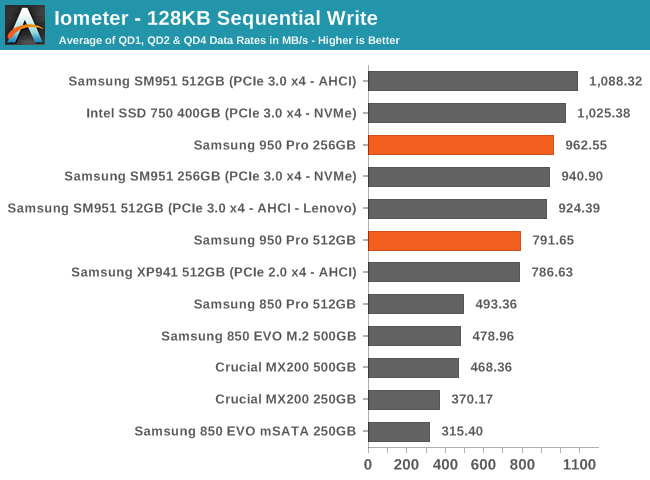
Even at low queue depths, most SSDs can spread a sequential write workload across multiple channels to achieve very high throughput. All of the PCIe drives perform well above the SATA limit but nowhere near the capacity of the PCIe links. The 512GB 950 Pro seems to again be encountering thermal throttling, and more severely than the SM951s we tested.
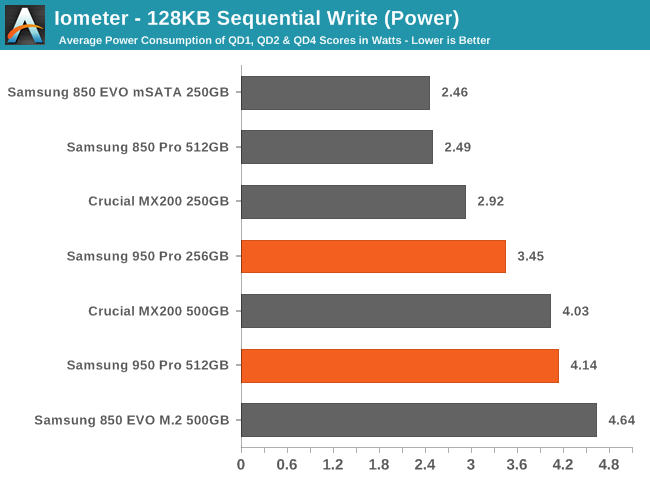
The average power consumption for writes is still on the high side by SATA standards, but is quite reasonable in light of the performance achieved.
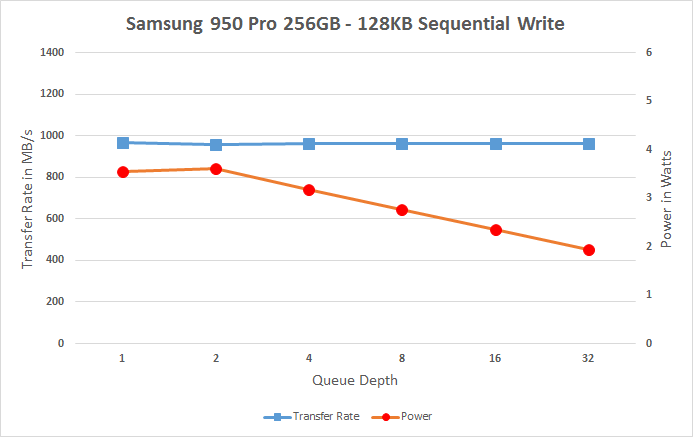 |
|||||||||
Performance across the sequential write test is mostly constant, but power isn't. The declines in power consumption in spite of increased queue depth are again most likely an artifact of whatever background processing is going on in the drive. On SATA drives, it's usually obvious from looking at the power meter when a drive has completed background processing and is truly idle and ready to run the next test, but with the lack of working power management for PCIe drives on our testbed I'm not so sure here. Overall it's probably a good sign that the drives were able to maintain high performance in spite of whatever else was going on, but given more cooling the 512GB can probably do much better.
Sequential Read Performance
Just like the random read test, sequential reads are tested across the span of a full drive and a representative sample of queue depths. Most operations involving large files (typically images and videos) fall under this test's purveiw, but streaming or playing even the highest resolution videos won't be a challenge for any of these drives. Copying files to another SSD or loading a new level in a video game would be more likely to show noticeable difference from better performance here.
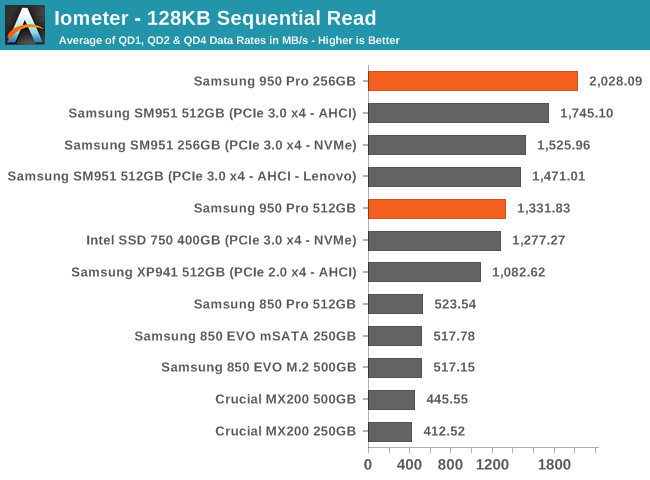
The sequential read performance is probably the best showcase of what the PCIe 3.0 x4 interface can do. The 256GB 950 Pro attains over half of the link speed, but the 512GB is again bogged down by something—relatively speaking, since it's still more than twice the speed of SATA and faster than even the Intel SSD 750. It's possible that the 950 Pro isn't faithfully implementing the secure form of the NVMe format command and some lingering fragmentation is preventing the 512GB drive from performing as specified. Read operations require less power to be supplied to the flash chip than for writes, but if the thermal throttling is all in the controller it could be showing up here as well.
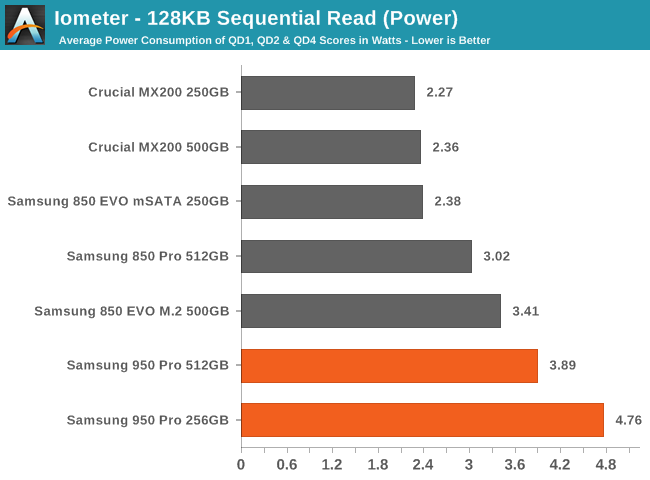
Relative to each other, the 950 Pro's power consumption is in line with the performance they're demonstrating, and proportionally much better than the SATA drives.
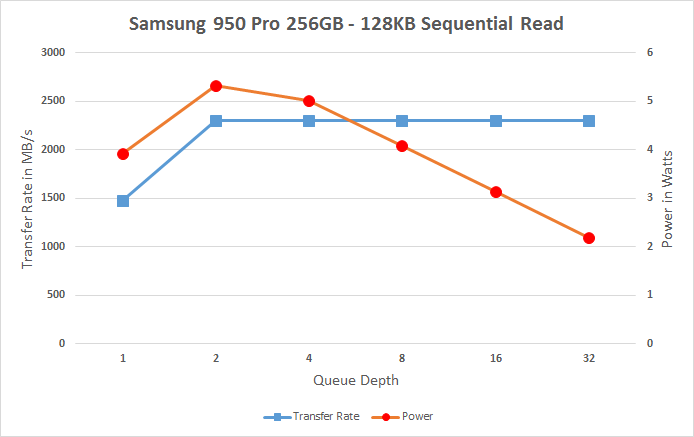 |
|||||||||
At queue depth 1, both of the 950 drives are performing similarly. When moving to higher queue depths the 256GB immediately hits 104% of its rated speed, but the 512GB doesn't improve any. (It's worth noting the differing scale for Transfer Rate in the graphs above.) The puzzling decline in power consumption at higher queue depths shows up again on the 256GB and definitely warrants deeper investigation.










142 Comments
View All Comments
MHz Tweaker - Monday, November 16, 2015 - link
I have an IT service company and have been doing IT for a few decades. I am with you on how incredibly annoying it is to work on some of the hodge podge of hardware that comes in for service. Specifically there are those that refuse to upgrade early P4's or Sempron single core systems with 512 or 256 megs of RAM. Certainly these should have failed by now. They barely run XP let alone modern security needed to protect them. Internally all our workstations are Z97, X99, x79, Z170's with 4690K's, 4790K's, 5930K, 3930K and 6700K CPUs. Every machine has a Samsung or Intel SSD for a boot drive and a Hitachi 4, 5 or 6TB drive for work and storage. All systems also have 16 or 32GB RAM. I am just amazed at how much time the average person wastes waiting on an entry level PC to do things. I mean many of us spend in excess of 40 hours a week at a keyboard. I get much more done when I keep my equipment in tip top shape and fresh. Nothing has a chance to break down. Many companies throw tons of money at "image" but internally the infrastructure is held together with bubble gum and band aids.Oh BTW, I got our first 950 Pro 512MB Yesterday :-)
Deders - Thursday, October 22, 2015 - link
Until Samsung announce again that SSD's are not meant to use sleep, their excuse for computers with 830/840's freezing for 30 seconds after waking up.BurntMyBacon - Friday, October 23, 2015 - link
@Deders: "Until Samsung announce again that SSD's are not meant to use sleep, their excuse for computers with 830/840's freezing for 30 seconds after waking up."Is this a known issue or are you just speculating about what might (probably?) occur in the future?
I am using quite a few 830s and have deployed quite a few more all (up to this point) without this issue. In my experience, they've been some of the most reliable drives I've used. I know of a few 840s without issues as well, but I've tried to avoid them as much as practical as I'm still not convinced the industry fully understands the long term consequences of simultaneously increasing leakage and cutting down the margin of error to get that third (fourth, fifth, etc.) bit in. I suspect it'll be fine on some (larger) process nodes, but the 840EVO issues suggests that there is a lower limit to how small you can get while trying to get that extra bit (and storing long term). In any case, it would be nice to know if there is something I should be looking out for here and whether practical mitigations exist.
bill.rookard - Sunday, October 25, 2015 - link
Agreed. I have several systems with the 830s in them and have zero problems with them. I avoided the 840s because those went with the TLC and I was iffy about them, and the 830s are rock solid and very fast.Chaser - Tuesday, October 27, 2015 - link
Boot times matter to me too. Makaveli must have a remote control while he's making his bagels.carl0ski - Monday, May 16, 2016 - link
I'd say the most annoying part is the Windows boot logo is a fixed time to complete.So even if Windows 7 8 10 boot up faster it still waits for the pretty video.
Turn it off from msconfig and windows 7 on 850 will boot in 3 seconds instead of 10 seconds
beginner99 - Thursday, October 22, 2015 - link
Most people that buy such a product usually are enthusiast and play around like over clocking. 10 sec more per boot is then pretty annoying.Makaveli - Thursday, October 22, 2015 - link
I'm from the era of overclocking with jumpers on a motherboard and far longer post times. If waiting 10 seconds for a machine to boot is too long while trying to get a stable overclock then do it in windows. Or does everyone in this generation have ADD?AnnonymousCoward - Thursday, October 22, 2015 - link
Oh, so time is only valuable to those with ADD? You're a fool.Makaveli - Thursday, October 22, 2015 - link
Go troll else where tool!